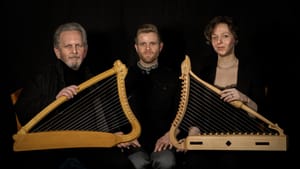Stay in the Loop
BSR publishes on a weekly schedule, with an email newsletter every Wednesday and Thursday morning. There’s no paywall, and subscribing is always free.
Loving a long-ago language
Penn Live Arts presents Benjamin Bagby’s Gregorius, The Holy Sinner

In 2023, Benjamin Bagby came to Philadelphia and gave a thrilling presentation of the tale of Beowulf (here’s my review). Recently, Penn Live Arts brought him back to share a saga less well-known but equally riveting: Gregorius, The Holy Sinner.
Director Bagby (also singing and playing the harp) was joined by two members of Sequentia, the Paris-based Medieval music ensemble he co-founded in 1977: Slovenian singer Jasmina Črnčič (voice and harp) and Brooklyn vocalist Lukas Papenfusscline (aka leiken). This trio took the audience into the Medieval world of the minnesänger, bards in a song-writing tradition that flourished from the 12th to the 14th centuries (minne was the Middle High German word for love).
An epic of a holy sinner
Gregorius is both a love story and a dense, twisty epic, written around the year 1200 by German poet Hartmann von Aue. “Here begins the strange story of a holy sinner” is how Hartmann opens his tale, and it’s a strange one indeed. Gregorius was a nobleman born in Aquitaine whose incestuous parents were twins. As a baby, he was put to sea in a small boat laden with gold and a beautiful jeweled ivory tablet (“I never had such a one,” says the poet) detailing his twisted aristocratic origins. Found by a fisherman, Gregorius grows up in a monastery as a promising scholar but turns his back on a spiritual life to become a wandering knight. He returns to Aquitaine, where he rescues an unmarried woman from an attacking army and marries her, only to discover, to both their horror, that he has married his mother.
Gregorius flees to the wilderness and lives as a penitent hermit, chained to a rock in the sea, but his presence is revealed in visions to Roman clerics seeking a new pope. Emaciated and near death, he is rescued by wise men (Hartmann intentionally echoing the Christmas story of the Magi) and brought to Rome, working miracles and healing the sick on the way (more echoes of Jesus). On his arrival, the city’s church bells magically ring of their own accord, and he is declared Pope. The “holy sinner” is reunited with his mother/aunt/wife, and the two live out their days in grace and forgiveness.
A manuscript meant for singing
Though the saga survives in manuscripts, it was not intended to be read silently. Written in a time without widespread literacy and well before printing, Gregorius was to be delivered orally, sung (accompanied by harp) for courtly gatherings undoubtedly transfixed by its scope and narrative drama. A story like this might require telling in a dozen long episodes, but Bagby has condensed the eloquent poem into 90 riveting minutes performed without intermission.
Hartmann (b. 1160/70 - d. 1210/20), born in Swabia, added Aue (his patron’s domain) to his professional name, and he was himself also a knight, so his descriptions of training and the chivalric code are particularly strong. Throughout this poem, God and the Devil are both omnipresent, evoking an era when the church and its quasi-magical narratives were the most powerful forces in the lives of nobles and peasants alike.
Hartmann sagely makes sure that all his clerics, including those from Rome, are portrayed as virtuous. And in the section where the love of these two siblings is overcome by a growing lust, instituted by the Devil’s jealousy at their fraternal happiness, this tale that is at its core quite salacious is rendered with a surprising sensitivity and nuance.
Hartmann, Chaucer, and Dickens
Such serial storytelling, meant to be delivered over successive nights, is a reminder of the enduring power of episodic works like The Canterbury Tales (1387-1400), The Decameron (1313-1375), and even Dickens’s popular 19th-century serializations. In Gregorius, the poet often puts himself forward in a quite modern way; these asides (always delivered by Bagby) are by turns intimate and humorous. Reminiscent of a Shakespeare epilogue, Hartmann begs the audience’s forbearance at the poem’s close, with thanks for listening and a request to “pray for me.”
The welcome addition of easily flowing supertitles rendered this Middle High German work perfectly understandable and dramatically approachable. Soprano and harpist Črnčič and tenor leiken are first-rate narrative singers, with vocal and emotional range that rendered their telling beautifully sculpted and pitch-perfect, and as the tale gained momentum, the duo gained in force and focus. But from the start, Bagby does something that seems magical. His sprechstimme, a combination of song and speech honed over four decades of scholarship and performance, brought the era thrillingly alive each time he spoke. He delivered the Medieval German text so clearly and with such feeling that it’s possible to feel the meter and hear the interior, slant, and end rhymes. Words began to seem familiar, their linguistic roots clear, and it seemed almost possible to understand this long-ago language.
An inspiring winter night
Gregorius was recreated as it might have been presented in those Medieval halls, and the architecture and ringing acoustics of the venue (a West Philadelphia church) enhanced the drama presented by these riveting interpreters. But it would undoubtedly have the same artistic impact in any environment in which the trio took up their graceful Romanesque harps, instruments based on a sculpture (ca. 1180) in the west portal of France’s Chartres Cathedral, another link with the Medieval world. The mesmerized audience was taken to another time and place, and at the epic’s close, we headed back into the winter night, amazed and inspired.
What, When, Where
Gregorius, The Holy Sinner. By Hartmann von Aue. Performed by Sequentia: Benjamin Bagby, Jasmina Črnčič, and leiken. January 30, 2025, at Philadelphia Episcopal Cathedral, 19 S 38th Street, Philadelphia. (215) 898-3900 or pennlivearts.org.
Accessibility
Philadelphia Episcopal Cathedral has steps leading into the sanctuary, but it is wheelchair-accessible via a side entrance. The performance space and accessible restrooms are all on the same level.
Sign up for our newsletter
All of the week's new articles, all in one place. Sign up for the free weekly BSR newsletters, and don't miss a conversation.

 Gail Obenreder
Gail Obenreder